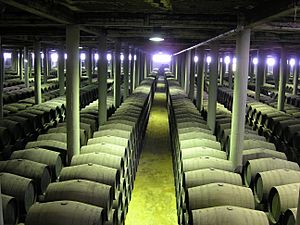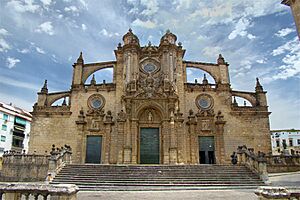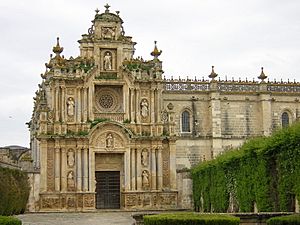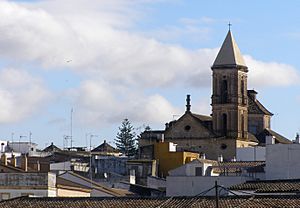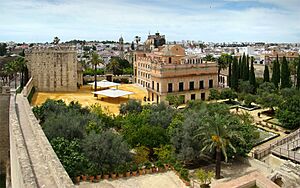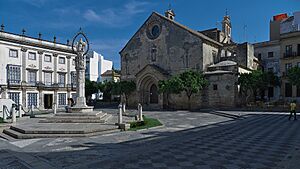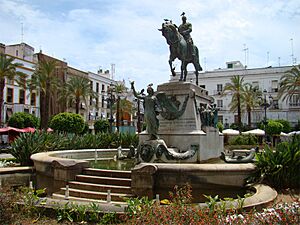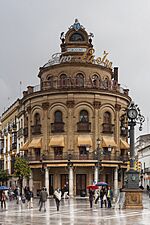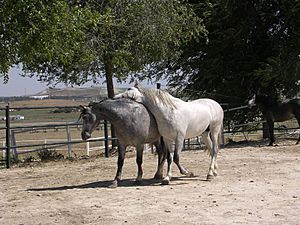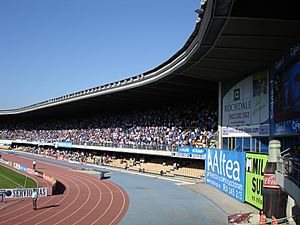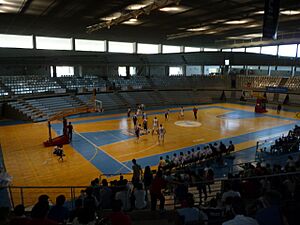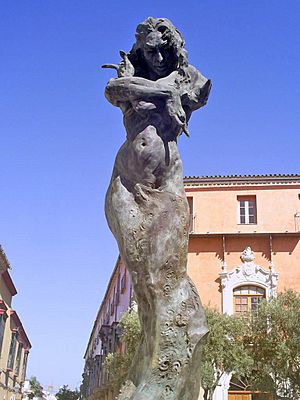Jerez de la Frontera facts for kids
Quick facts for kids
Jerez de la Frontera
|
|||
|---|---|---|---|
 |
|||
|
|||
| Country | Spain | ||
| Autonomous community | Andalusia | ||
| Province | Cádiz | ||
| Area | |||
| • Total | 1,188.23 km2 (458.78 sq mi) | ||
| Elevation | 56 m (184 ft) | ||
| Population
(2018)
|
|||
| • Total | 212,879 | ||
| • Rank | 25th, Spain | ||
| • Density | 179.1564/km2 (464.0129/sq mi) | ||
| Demonym(s) | Jerezanos | ||
| Time zone | UTC+1 (CET) | ||
| • Summer (DST) | UTC+2 (CEST) | ||
| Postal code |
11401 – 11409
|
||
Jerez de la Frontera (pronounced "heh-RETH day lah fron-TEH-rah") is a lively city in Andalusia, Spain. It's often called just Jerez. This city is located in the southwest of Spain, near the Atlantic Ocean. It sits on a flat plain called the Campiña de Jerez, with the Guadalete river flowing nearby.
Jerez is the biggest city in the province of Cádiz by population. In 2020, about 213,105 people lived there. The city's area is about 1,188 square kilometers, which includes parts of the Los Alcornocales Natural Park.
For a long time, making wine has been the most important part of Jerez's economy. The famous local wine, Sherry, was mostly made for people in other countries, especially Britain. Today, Jerez is also known for its exciting Grand Prix motorcycle racing at the Circuito de Jerez. Other big events include the Feria de Jerez and Holy Week celebrations.
Contents
- What's in a Name? The Etymology of Jerez
- A Journey Through Time: The History of Jerez
- What Drives Jerez? The Economy
- Where is Jerez? Its Geography and Climate
- Exploring Jerez: Main Sights
- Culture in Jerez: Wine, Horses, and Flamenco
- Sports in Jerez: Racing, Football, and More
- Getting Around: Transportation in Jerez
- People and Population
- Famous People from Jerez
- Jerez Around the World: Sister Cities
- Images for kids
- See also
What's in a Name? The Etymology of Jerez
The name Jerez comes from the Arabic word Sharīsh. This name was used when Muslims ruled this part of Spain, known as Al-Andalus. Over time, the spelling changed from Xerez to Jerez.
The second part of the name, de la Frontera, means "of the frontier" or "of the border". This is because Jerez was once on the border between the lands controlled by Christians and those controlled by Moors in the 13th century.
You might still see the old spelling Xerez in some places. For example, the city's main football team is called Xerez Deportivo FC. The name of the wine, sherry, also comes from this old spelling.
A Journey Through Time: The History of Jerez
Jerez has a very long history, with people living here since the Copper Age.
Early Settlements and Roman Times
The first major settlement in the area was built by the Tartessos people around 3,000 BC. Later, the Romans took over and called a nearby city Asta Regia.
The Middle Ages: From Muslims to Christians
After the Roman Empire fell, different groups like the Vandals and Visigoths ruled. Then, in the early 700s, Muslims conquered the area. Jerez became an important city during this time. Its defense system and the layout of the old town were built in the 12th and 13th centuries.
In 1261, the city was taken by Castilian Christian forces. The Muslim people living there tried to rebel but were defeated in 1264. Jerez grew into a major city in southern Andalusia because of its farming and large population.
A Jewish community also lived in Jerez for many years. Today, a street called "Juderia" (meaning Jewish quarter) shows where their old neighborhood used to be.
Modern History: Trade, Wine, and Change
When the Americas were discovered in 1492, Jerez became very successful. Its closeness to the ports of Seville and Cádiz helped with trade. Many people from other European countries, like England and Italy, moved to Jerez. They were interested in the wine business.
Even though there were some tough times in the 1600s, Jerez continued to grow. It became famous around the world for its wine. In the late 1800s, there was some social unrest among farmers in Jerez.
What Drives Jerez? The Economy
Jerez's economy has always been strongly linked to its wine industry. The city exports sherry wine all over the world.
Besides wine, farming fruits, grains, and vegetables is important. Raising horses and cattle is also a big part of the local economy. Jerez is home to the Spanish Military Stud farm, called the Yeguada Militar de Jerez de la Frontera.
After some challenges in the wine industry in the 1990s, Jerez has worked to grow other businesses. Tourism has become very successful. People love visiting Jerez for its wine, flamenco music and dance, beautiful horses, and exciting festivals like MotoGP races. The city also has Jerez Airport and is becoming an important place for moving goods around western Andalusia.
Where is Jerez? Its Geography and Climate

Jerez de la Frontera is in the Campiña de Jerez region. It is the largest municipality in the Cadiz province and the sixth largest in Spain. The Guadalete River flows through the region. There are also wetlands, like the lagoons of Medina and Torrox, and parts of the Los Alcornocales Natural Park.
The area is famous for its sherry wine, which is grown in a special "triangle" between Jerez, Sanlúcar de Barrameda, and El Puerto de Santa María. Jerez is about 12 kilometers from the Atlantic Ocean. It's also part of a larger group of cities around the Bay of Cádiz.
Jerez's Weather: Hot Summers and Mild Winters
Jerez has a Mediterranean climate, which means it has mild, short winters and long, hot summers. Most of the rain falls from October to January. Summers are usually very dry.
The average temperature during the day is about 24.4°C (76°F). At night, it's about 11.9°C (53°F). Jerez gets around 570 mm (22 inches) of rain each year. The city enjoys about 2,965 hours of sunshine annually. Snow is extremely rare in Jerez.
Exploring Jerez: Main Sights
Jerez has many interesting places to visit, from old churches to grand palaces.
Religious Buildings: Churches and Chapels
- The Cathedral: A beautiful and important church.
- Church of San Miguel: Built in the 15th century, it mixes Gothic and Baroque styles.
- Church of San Mateo: The oldest church in the city, built in the Gothic style.
- The Charterhouse: A historic monastery.
- Church of Santiago: Dates back to the time of King Alfonso X of Castile.
- Church of San Dionisio: Built around 1457.
Grand Palaces and Manors
Jerez is home to many impressive old houses and palaces, showing its rich history. Some examples include:
- Palace of Marqués de Montana
- Palacio Dávila
- Palacio de Bertemati
- Palacio de Campo Real
- Palacio de Villavicencio
Museums: Learning About Jerez
- Archaeological Museum: Here you can see ancient objects found in the area.
- Bullfighting Museum: Learn about the history of bullfighting.
- Museos de la Atalaya: A group of museums.
- Museo del Enganche: Features horse-drawn carriages.
Other Famous Landmarks
- Old City Hall of Jerez de la Frontera: Built in 1575, it's a historic government building.
- Alcazar of Jerez de la Frontera: An old Moorish fortress from the 11th century.
- Zoo and Botanical Garden of Jerez: A great place to see animals and plants.
- Villamarta Theatre: A beautiful theater for performances.
- Gallo Azul: A unique building built in 1927.
Culture in Jerez: Wine, Horses, and Flamenco
Sherry Wine: A Jerez Specialty
Jerez is known worldwide as the capital of sherry wine. This special fortified wine is made from white grapes grown near the city. Winemaking has been happening here since the Phoenicians introduced it around 1100 BC!
Many of the famous wineries, called bodegas, were started by British families. Some of the most important ones include:
- González Byass: Founded in 1835, it makes the famous fino sherry Tío Pepe.
- Williams & Humbert: Started in 1877, it produces sherry wines and brandies.
- Grupo Garvey: Founded in 1780.
- Grupo Estévez: Owns very old bodegas like Valdespino, which dates back to 1430.
Jerez also produces Brandy de Jerez, a type of brandy used in Spanish cooking.
Carthusian Horses: A Special Breed
Jerez is the original home of the Carthusian horse, a special type of Andalusian horse. For nearly 400 years, monks at the Charterhouse of Jerez de la Frontera carefully bred these horses. They kept their bloodline pure, even when others were mixing breeds.
The city is also home to the Royal Andalusian School of Equestrian Art. This famous riding school is like the Spanish Riding School in Vienna. You can see amazing horse shows there.
Another important horse place is the Yeguada Militar de Jerez de la Frontera. This is the Spanish military's stud farm, where they breed purebred Andalusian and Arabian horses.
In 2002, Jerez hosted the 2002 FEI World Equestrian Games, a big international horse competition.
Flamenco: The Heartbeat of Jerez

Jerez is a very important center for flamenco, a passionate Spanish art form with singing, dancing, and guitar playing. The Andalusian Centre of Flamenco was created in 1993 to protect and promote flamenco. It has a museum and library with historical documents and artifacts related to flamenco. Many famous flamenco artists, like Lola Flores and José Mercé, are from Jerez.
Exciting Festivals in Jerez
Jerez loves to celebrate!
- Grand Prix motorcycle racing: Since 1987, the Circuito de Jerez hosts this huge motorcycle race every May. Thousands of fans come to watch.
- Feria del Caballo (Horse Fair): This is one of Spain's most famous fairs. It happens for a week in May, right after the motorcycle Grand Prix. It's all about horses, with open booths where everyone can enjoy food, drinks, and dancing.
- Holy Week: Like other cities in Andalusia, Jerez celebrates Holy Week with religious parades. Brotherhoods carry large floats through the streets. It's a very important and beautiful tradition.
- Christmas: During Christmas, many clubs celebrate with public festivals called zambombas. People gather to sing Christmas carols, dance, and eat.
Other festivals include the Flamenco festival de Jerez, Carnival of Jerez, and Fiestas de la Vendimia (Grape Harvest Festival).
Sports in Jerez: Racing, Football, and More
Circuito de Jerez: A Racing Hub

Jerez is known as the first motorcycling world capital. The Circuito de Jerez is a famous racetrack where the annual MotoGP Motorcycle Grand Prix takes place.
This track is also used by Formula One teams for testing their cars. It even hosted the F1 Spanish Grand Prix several times in the past and the European Grand Prix in 1994 and 1997.
Chapín Sports Complex: Home to Many Sports
The Complejo Municipal de Chapín is a large sports area. It has a football stadium, a baseball field, and facilities for horse riding.
The Estadio Municipal de Chapín is a multi-purpose stadium built in 1988. It can hold over 20,000 spectators. It was updated in 2002 to host the 2002 FEI World Equestrian Games. The stadium is home to the football team Xerez Deportivo FC. It also has a running track and is used for track and field events.
Jerez also has basketball teams, a baseball team, and a futsal team that play in different sports halls. The city's rugby club, Club Rugby Xerez, trains at the Pradera Hípica in Chapín.
Other Sports Venues
- Domecq Stadium: This was the first football stadium in Jerez, built in 1923 and demolished in 1988.
- Juventud Stadium: The oldest stadium still standing in the city, it holds 5,000 people and is home to Jerez Industrial CF.
Getting Around: Transportation in Jerez
Jerez Airport
Jerez Airport, also known as Aeropuerto de La Parra, is the main airport for the province of Cádiz. It's located about 8 kilometers north of the city and connects Jerez to other places by train and bus. It was built in 1937 and opened for civilian flights in 1992.
Train Travel
Jerez has had a railway line since 1854, one of the first in Spain. It was first used to transport wine barrels. Jerez de la Frontera railway station is very busy, serving more passengers than Cádiz's main station. There's also a train station at the airport, connecting it to nearby cities like Cádiz and Sevilla.
Bus Services
Jerez has 16 local bus lines that help people get around the city. There are also intercity buses that connect Jerez to many other towns and cities, including Madrid and Málaga.
Roads and Bike Lanes
Jerez is connected by several important highways, like the A-4 and AP-4, which link it to Seville and Cádiz. The city also has about 41 kilometers of bike lanes, making it easy to cycle along the main avenues.
People and Population
Jerez is the most populated city in the province of Cádiz. In 2020, it had 213,105 residents. It is the fifth largest city in Andalusia and the 25th largest in Spain.
Population Growth Over Time

- Source: INE
Where People Live: Population Distribution
Jerez de la Frontera is made up of the main city and several smaller villages and rural neighborhoods. Here's a look at some of them:
| Community Name | Type | Population (2012) | Distance from City Centre |
|---|---|---|---|
| Cuartillos | Rural neighborhood | 1,300 inhabitants | 11 km east |
| El Portal | Rural neighborhood | 700 inhabitants | 6 km south |
| Estella del Marqués | Village | 1,650 inhabitants | 5.5 km east |
| Guadalcacín | Village | 5,500 inhabitants | 5 km northeast |
| Jerez de la Frontera (city) | City | 190,000 inhabitants | |
| La Barca de la Florida | Village | 4,353 inhabitants | 20 km east |
| Nueva Jarilla | Village | 1,600 inhabitants | 15 km northeast |
People from Around the World: Immigration
Jerez is home to people from many different countries. In 2011, about 2.62% of the population were immigrants. Many came from other European countries, as well as from the Americas and Africa.
|
|
||||||
|
|
|
|
|
|
||
|
|
|
|
|
|||
|
|
|
|
|
|||
|
|
|
|
||||
| AFRICA |
|
|
|
|
||
|
|
|
|
|
|||
| AMERICAS |
|
|
|
|
||
|
|
|
|
|
|||
|
|
|
|
|
|||
| ASIA |
|
|
|
|
||
|
|
|
|
|
|||
| TOTAL |
|
|
|
|
||
Famous People from Jerez
Many talented people come from Jerez de la Frontera, including:
- Lola Flores: A very famous singer, dancer, and actress.
- José Mercé: A well-known flamenco singer.
- Daniel Güiza: A professional football player.
- Álvar Núñez Cabeza de Vaca: An explorer who traveled through North America.
- Miguel Primo de Rivera: A former Prime Minister of Spain.
- Mala Rodriguez: A popular hip-hop artist.
- Luis Coloma: A writer, creator of Ratoncito Pérez (the Spanish Tooth Fairy).
Jerez Around the World: Sister Cities
Jerez de la Frontera has "sister city" relationships with many cities around the world. These connections help promote cultural exchange and friendship. Some of its sister cities include:
 Arles, France
Arles, France Tequila, Mexico
Tequila, Mexico Bristol, United Kingdom
Bristol, United Kingdom Cognac, France
Cognac, France Kiyosu, Japan
Kiyosu, Japan El Paso, United States
El Paso, United States
Images for kids
See also
 In Spanish: Jerez de la Frontera para niños
In Spanish: Jerez de la Frontera para niños






